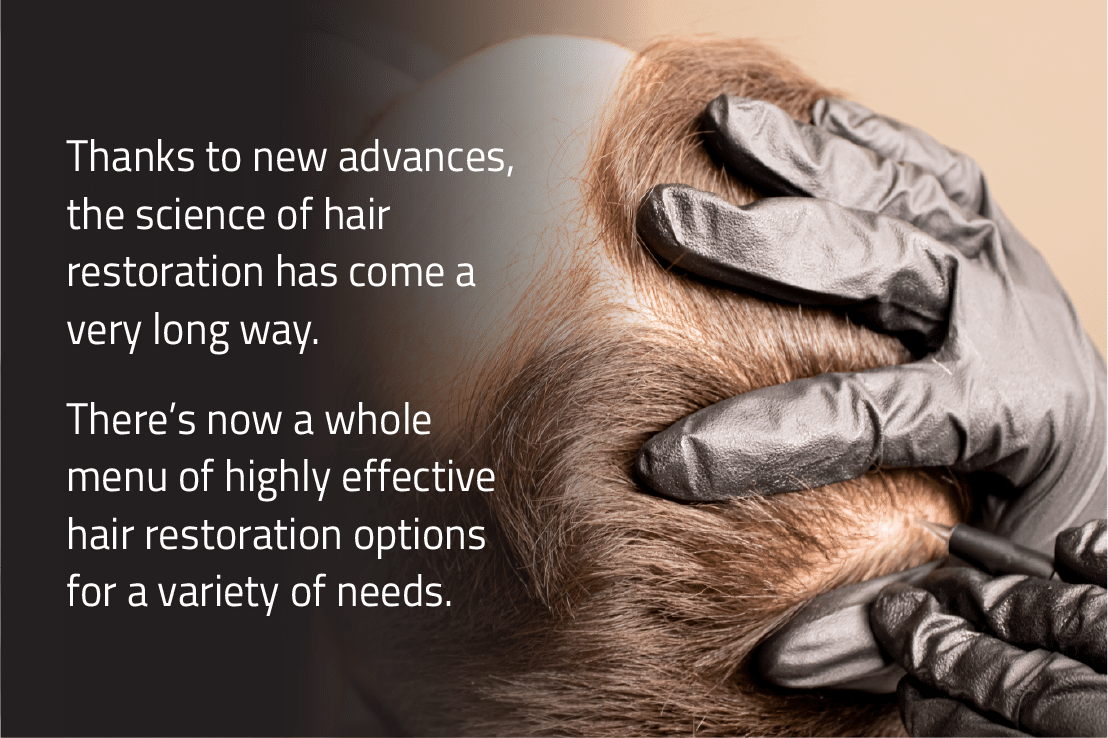The most recent data from the International Society of Hair Restoration Surgeons shows that an estimated 2 million patients sought hair restoration services — both surgical and non-surgical—worldwide.
Thanks to new advances, the science of hair restoration has come a very long way, and patients are seeing results never dreamed of before.
In addition to drugs like minoxidil and finasteride, which help you keep existing hair and increase hair thickness, there’s now a whole menu of highly effective hair restoration options for a variety of needs.

Here’s a brief overview of what hair restoration methods are available for you now, how they’re better than past hair replacement options, and a look at cutting edge techniques that are making your options for a full head of hair even better.
Hair Transplant Surgery: Old vs. New
Hair transplantation used to involve cutting strips of scalp from the back of the head and grafting it onto areas in the front where hair was thinning. This older method, known as follicular unit transplantation (FUT) or strip hair transplant, is still in use today.
However, advancements in the science and technology of hair transplantation led to a better, more natural-looking hair restoration method that is now much more widely used: follicular unit extraction (FUE).
FUE: The Gold Standard for Modern Hair Transplants
This hair transplant method uses smaller grafts for less scarring and more natural placement of transplanted hair follicles.
What’s more, FUE can be performed as either a shaved or Shave-Less FUE hair transplant procedure, making it not only a low-recovery-time method but also one that’s minimally disruptive to your appearance.
Cutting-edge tech has also made FUE faster and more effective than ever before.
When combined with newer hair implant methods like DHI (direct hair implantation), it can provide truly transformative results for patients.
Robot-Assisted FUE
New advances in robotic-assisted transplants are also revolutionizing how FUE is performed.
These new technologies have helped streamline the process, making larger transplants possible in shorter sessions for transformative results.
However, robotic hair transplant technology has its limitations, and it should only be used by under the careful guidance of an experienced hair restoration surgeon with proper training and skill.
Non-Surgical Hair Restoration Techniques and Technologies
In addition to hair transplant surgeries, those suffering from hair loss now have a variety of non-surgical hair restoration options to choose from.
Non-Surgical Hair Restoration Methods:
- Minoxidil (Rogaine), either topical or oral: Helps thicken existing hair and stimulate hair growth
- Finasteride (Propecia): Blocks the hormone that causes hair loss and stimulates hair regrowth
- Platelet-Rich Plasma Therapy: Uses the restorative power of blood plasma to repair damaged hair follicles and stimulate new growth
- PDO Threads: Micro-polydiaxonone (surgical suture) threads implanted just below the scalp surface stimulate dormant hair follicles to regrow hair
- Low Level Laser Therapy (LLLT): Uses a special laser to stimulate hair regrowth
These non-surgical methods can be an excellent choice for younger patients and those in the early stages of hair loss.
Their main limitation is that they cannot revive dead hair follicles, so older patients or those in the advanced stages of loss may not get the same regenerative benefits.
Which New Hair Restoration Technique is Right for Me?
Only a hair loss expert can properly assess your situation and recommend the most beneficial new hair restoration therapies for your individual needs.
Find out which of these newer methods can help you get the hair restoration results you want by calling North Atlanta Hair Restoration at 678-845-7521 today — or click here to book online.
Our lead surgeon, Dr. Daniel A. Danyo, and his veteran team specialize in all the latest hair restoration techniques, and they bring artistry and precision to every hair restoration.
Don’t wait to find out what the latest innovations in hair restoration can do for you.
Questions and Answers About Hair Transplantation
What is a robotic hair transplant?
A robotic hair transplant is a hair restoration surgery performed with the help of a state-of-the-art robotic system.
Robotic hair transplants are usually FUE procedures where a special robotic arm, using an optical guidance system, harvests the follicular units from the donor site.
While there are many competing robotic hair transplant technologies, including ARTAS and NeoGraft, they work on the same general principles.
Newer robotic systems can also assist in implantation, and many use advanced imaging to do things like optimize the donor site, plan the hairline, guide placement for individual grafts, and more.
These robotic systems can allow for impressive speed and precision, but they do have certain drawbacks. Due to the limitations of their optical imaging technology, they are not recommended for use on curly or lighter hair.
They may also have higher transection rates, and getting natural-looking results with these systems can sometimes be tricky. So be sure to choose a surgeon-led procedure if you go this route.
Are there new hair restoration methods to help me keep my hair?
There are! In addition to minoxidil and finasteride therapies, which can work very well in the early stages of hair loss, newer hair restoration techniques like PRP and PDO threads can help stimulate new hair growth in damaged or dormant hair follicles.
Am I too young for hair restoration surgery?
Although hair transplants used to be recommended only for those in the more advanced stages of baldness, new advancements in hair transplant surgery have made them a good choice for many in the early stages, too.
Due to minimally invasive harvesting methods like FUE, patients facing early-onset baldness in their 30s or even their 20s can be proactive about preserving their hair before the loss becomes noticeable.

When performed by an expert hair restoration surgeon, these newer methods produce minimal scarring and preserve the donor site for harvesting in the future.
Plus, traditional and No-Shave FUE procedures are much more discreet than older hair transplant methods, so it’s not as obvious that you’ve had anything done.


